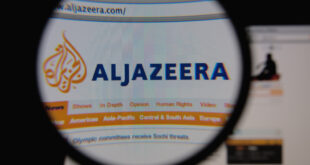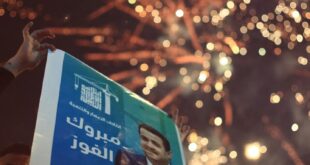Salvo of more than 40 projectiles sets off alarms in 90 Israeli communities; no injuries in strikes that targeted Mount Meron area; IDF hits terror infrastructure in response
The Hezbollah terror group in Lebanon fired a barrage of dozens of rockets into Israel on Saturday in a move it called “an initial response” to the alleged Israeli killing of Hamas terror chief Saleh al-Arouri in Lebanon last week. There were no reports of injuries.
The Israel Defense Forces said that some 40 rockets were fired from Lebanon at the Mount Meron area of northern Israel. Hezbollah said it targeted an Israeli military installation in the area with 62 “various types of missiles.”
The Iran-backed terror group said in a statement that the attack was “part of the initial response to the crime of assassinating the great leader Sheikh Saleh al-Arouri.”
The rocket salvo triggered incoming rocket and drone alerts in 90 communities across northern Israel, but the IDF said only the Mount Meron area was targeted.
Video circulating on social media showed smoke in a number of areas in the national park.
An hour later, sirens were again triggered in 40 communities in northern Israel, as several more projectiles were fired by Hezbollah at the Metula and Margaliot areas on the border.
In the afternoon, several more missiles were fired by Hezbollah at the northern communities of Yiftah and Avivim, with no reports of injuries.
The army said it struck a terror cell in southern Lebanon, responsible for some of the rocket launches at Mount Meron.
Later, the IDF said it carried out several waves of airstrikes on Hezbollah sites in Lebanon in response to the attacks on northern Israel.
In the first wave, the IDF said it hit targets in Ayta ash-Shab, Yaroun, and Ramyah, including rocket launch positions, military sites, and other infrastructure used by the terror group.
In a second wave, the IDF said fighter jets carried out strikes on two “significant” military compounds belonging to Hezbollah.
The sites, according to the IDF, housed infrastructure used by Hezbollah’s air defense unit.
The IDF said fighter jets and other aircraft hit further Hezbollah sites in southern Lebanon’s Rab el-Thalathine, Ramyah, Meiss el-Jabal, and Ayta ash-Shab.
The targets included Hezbollah cells, rocket launch positions, a command center, and other infrastructure used by the terror group, according to the IDF.
The IDF said a drone also struck the cell behind the later attack on Metula.
Amid the Israeli Air Force’s strikes, the IDF said Hezbollah fired a surface-to-air missile at an Israeli military drone over Lebanon, which did not hit the device.
The barrage, one of the largest since the start of skirmishes on the northern border linked to the outbreak of the Israel-Hamas war on October 7, came a day after Hezbollah chief Hassan Nasrallah threatened that Israel’s northern residents would be “the first to pay the price if a full-scale war were to erupt” along the front.
Nasrallah also used the address to repeat many of the same threats against Israel that he made earlier this week, again vowing to avenge deputy Hamas chief Arouri’s killing in Beirut while remaining vague on the specifics.
Nasrallah said that all of Lebanon would be exposed to further Israeli strikes if the group did not react to the assassination of Arouri in Beirut, allegedly carried out by Israel.
“The response is coming. The decision has already been made. The matter now depends on what will unfold on the ground and on Allah,” Nasrallah said.
“We cannot remain silent on a violation of this magnitude because it means the whole of Lebanon would be exposed,” he asserted, adding that allowing Israel to succeed in its operations in Gaza would lead to the IDF following suit in Lebanon.
The attack on Arouri has sparked fears of a broader conflagration because he was the most high-profile figure to be killed since October 7 and because his death came in the first strike on the Lebanese capital since hostilities started.
Lebanon filed a complaint to the UN Security Council over the killing of Arouri, calling it the “most dangerous phase” of Israeli attacks on the country.
The complaint, dated January 4 but seen by Reuters on Friday, said Israel used six missiles in the attack that killed Arouri and added that Israel uses Lebanese airspace to bomb Syria.
The complaint appeared largely symbolic and is unlikely to lead to any tangible action against Israel.
Nasrallah claimed Friday that Hezbollah carried out 670 operations on the border since October 8, destroying a “large number of Israeli vehicles and tanks,” as well as technical and intelligence collection equipment, “exhausting Israel” on the front.
“No site along the border has been spared” in the attacks, he said, adding that 48 Israeli border positions and 11 rear bases were targeted.
Some experts were skeptical of the claims, posing that the figures were directed at the terror group’s supporters in Lebanon to justify the organization’s losses since it began launching attacks.
Since the deadly Hamas onslaught of October 7, in which some 1,200 people were slaughtered, mostly civilians, and around 240 were taken hostage, Hezbollah and allied Palestinian terror factions have engaged in daily cross-border clashes with Israeli troops along the Lebanon border. Lebanese terrorists have also targeted Israeli civilians and their homes, forcing tens of thousands to evacuate the area.
The fighting along the border has resulted in four civilian deaths on the Israeli side, as well as the deaths of nine IDF soldiers.
Hezbollah has named 153 members who have been killed by Israel during the ongoing skirmishes, mostly in Lebanon but some also in Syria. In Lebanon, another 19 operatives from other terror groups, a Lebanese soldier, and at least 19 civilians, three of whom were journalists, have been killed.
Nasrallah added in his speech that its current operations on the southern borders opened a “historic opportunity” for Lebanon to liberate its land occupied by Israel.
Israel’s political and military leaders have said repeatedly since October 7 that Hezbollah will have to withdraw its forces from the border area to north of the Litani River, as required by 2006’s UN Resolution 1701, and that either this will be achieved diplomatically or by force.
Defense Minister Yoav Gallant reiterated the position Friday during a visit to the northern border and warned time was running out for a diplomatic solution.
“We prefer the path of an agreed-upon diplomatic settlement, but we are getting close to the point where the hourglass will turn over,” Gallant says during a situational assessment at the IDF’s Northern Command base.
The territory Lebanon claims remains occupied following Israel’s withdrawal from the country’s south in 2000 includes the disputed Mount Dov region, also known as the Shebaa Farms, the Kfar Shouba hills and the Lebanese side of the village of Ghajar.
Israel and the United Nations say those areas were captured from Syria, and not Lebanon.
Hezbollah is estimated to have some 150,000 rockets and missiles, including thousands or tens of thousands with the range to reach central Israel and hundreds of precision-guided missiles.
 Eurasia Press & News
Eurasia Press & News


